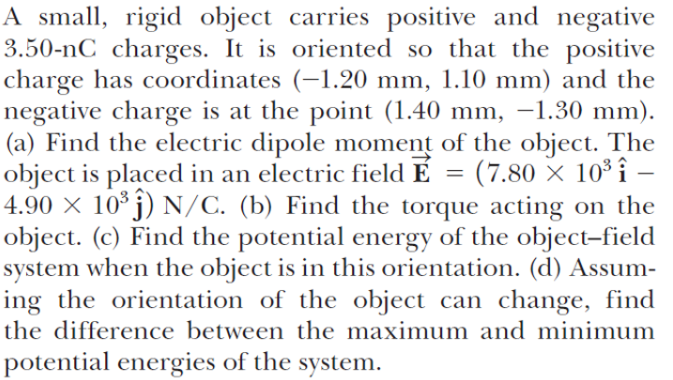A small, rigid object carries positive and negative 3.50-nC charges. It is oriented so that the positive charge has coordinates (-1.20 mm, 1.10 mm) and the negative charge is at the point (1.40 mm, –1.30 mm). (a) Find the electric dipole moment of the object. The object is placed in an electric field É 4.90 × 10° j) N/C. (b) Find the torque acting on the object. (c) Find the potential energy of the object-field system ing the orientation of the object can change, find the difference between the maximum and minimum (7.80 x 103 î – - when the object is in this orientation. (d) Assum- potential energies of the system.
A small, rigid object carries positive and negative 3.50-nC charges. It is oriented so that the positive charge has coordinates (-1.20 mm, 1.10 mm) and the negative charge is at the point (1.40 mm, –1.30 mm). (a) Find the electric dipole moment of the object. The object is placed in an electric field É 4.90 × 10° j) N/C. (b) Find the torque acting on the object. (c) Find the potential energy of the object-field system ing the orientation of the object can change, find the difference between the maximum and minimum (7.80 x 103 î – - when the object is in this orientation. (d) Assum- potential energies of the system.
Physics for Scientists and Engineers: Foundations and Connections
1st Edition
ISBN:9781133939146
Author:Katz, Debora M.
Publisher:Katz, Debora M.
Chapter24: Electric Fields
Section: Chapter Questions
Problem 78PQ
Related questions
Question

Transcribed Image Text:A small, rigid object carries positive and negative
3.50-nC charges. It is oriented so that the positive
charge has coordinates (-1.20 mm, 1.10 mm) and the
negative charge is at the point (1.40 mm, –1.30 mm).
(a) Find the electric dipole moment of the object. The
object is placed in an electric field É
4.90 × 10* j) N/C. (b) Find the torque acting on the
object. (c) Find the potential energy of the object-field
system when the object is in this orientation. (d) Assum-
ing the orientation of the object can change, find
the difference between the maximum and minimum
= (7.80 × 10³ î –
potential energies of the system.
Expert Solution
This question has been solved!
Explore an expertly crafted, step-by-step solution for a thorough understanding of key concepts.
This is a popular solution!
Trending now
This is a popular solution!
Step by step
Solved in 2 steps with 2 images

Knowledge Booster
Learn more about
Need a deep-dive on the concept behind this application? Look no further. Learn more about this topic, physics and related others by exploring similar questions and additional content below.Recommended textbooks for you

Physics for Scientists and Engineers: Foundations…
Physics
ISBN:
9781133939146
Author:
Katz, Debora M.
Publisher:
Cengage Learning

Principles of Physics: A Calculus-Based Text
Physics
ISBN:
9781133104261
Author:
Raymond A. Serway, John W. Jewett
Publisher:
Cengage Learning

Physics for Scientists and Engineers
Physics
ISBN:
9781337553278
Author:
Raymond A. Serway, John W. Jewett
Publisher:
Cengage Learning

Physics for Scientists and Engineers: Foundations…
Physics
ISBN:
9781133939146
Author:
Katz, Debora M.
Publisher:
Cengage Learning

Principles of Physics: A Calculus-Based Text
Physics
ISBN:
9781133104261
Author:
Raymond A. Serway, John W. Jewett
Publisher:
Cengage Learning

Physics for Scientists and Engineers
Physics
ISBN:
9781337553278
Author:
Raymond A. Serway, John W. Jewett
Publisher:
Cengage Learning

Physics for Scientists and Engineers, Technology …
Physics
ISBN:
9781305116399
Author:
Raymond A. Serway, John W. Jewett
Publisher:
Cengage Learning

College Physics
Physics
ISBN:
9781285737027
Author:
Raymond A. Serway, Chris Vuille
Publisher:
Cengage Learning